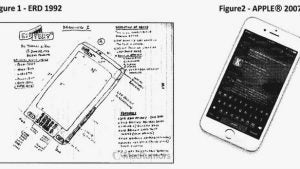Apple faces crazy iPhone lawsuit over 24-year-old doodles

Apple is facing a lawsuit over claims that it stole designs for the iPhone, iPad, and iPod from a US citizen.
Florida resident Thomas S. Ross says that a number of Apple devices infringe on concept drawings created way back in 1992. Ross created three separate hand-drawn designs, which he believes are sufficiently detailed as to warrant legal action. The filing argues that the devices depicted in the drawings “embodied a fusion of design and function in a way that never existed prior to 1992”.
The court filing continues: “What Ross contemplated was a device that could allow one to read stories, novels, news articles, as well as look at pictures, watch video presentations, or even movies, on a flat touch-screen that was back-lit.”
 (Image credit: MacRumors)
(Image credit: MacRumors)
The filing also describes a device that included communication functions – like a phone or modem – as well as input/output capability and media storage.
Ross originally applied for a utility patent for his drawings in November 1992. However, the US Patent and Trademark Office declared the application abandoned in April 1995 as Ross failed to pay the application fees. Ross also submitted a copyright application for his drawings with the US Copyright Office two years ago.
 (Image credit: MacRumors)
(Image credit: MacRumors)
The bold plaintiff says he has experienced “great and irreparable injury that cannot fully be compensated or measured in money”. Nevertheless, he has requested $10 billion in restitution, as well as royalties totalling 1.5% of revenue on global sales for the supposedly infringing devices: the iPhone, iPad, and iPod.
Related: iPhone 7
The Refresh: Catch up on the latest tech news
What do you think of this story? Let us know in the comments.


